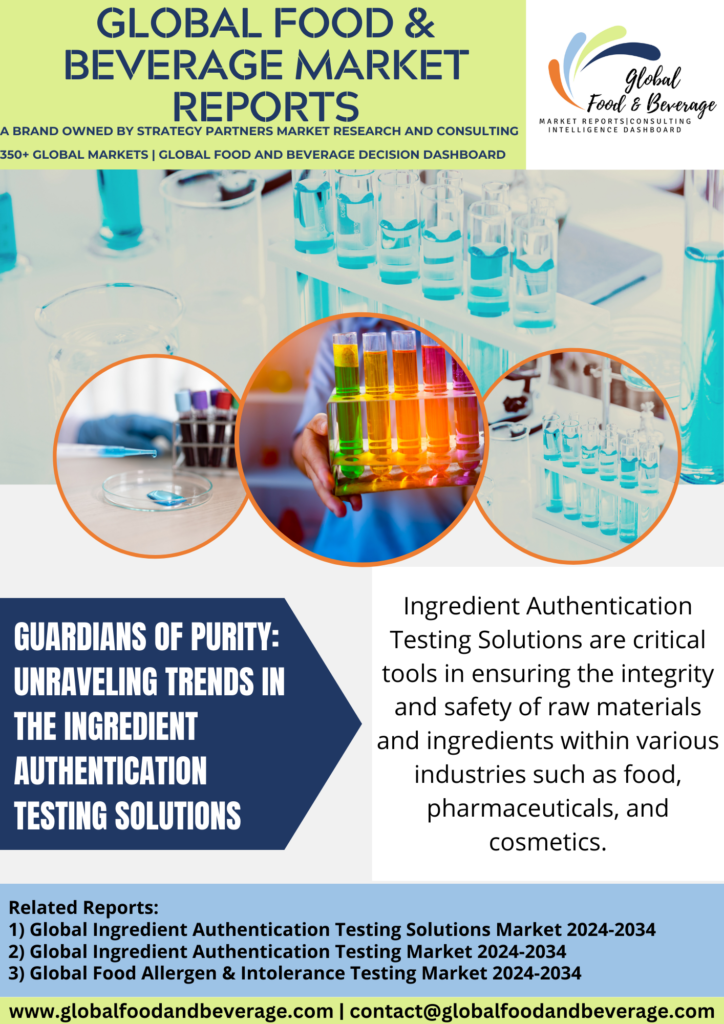Guardians of Purity: Unraveling Trends in the Ingredient Authentication Testing Solutions Market

Ingredient authentication testing solutions have become indispensable tools for industries seeking to ensure the genuineness, quality, and safety of their raw materials. These solutions employ advanced analytical techniques to authenticate and verify the identity of ingredients, addressing concerns related to fraud, mislabeling, and contamination.
DNA testing is a cutting-edge approach widely used in ingredient authentication. It involves analyzing the genetic material of ingredients to confirm their origin. This method is particularly effective in detecting adulteration or substitution in high-value commodities, such as spices, herbs, and premium foods. By comparing the DNA profiles of tested samples with known reference samples, companies can ascertain the authenticity of their ingredients.
Chromatography techniques, including high-performance liquid chromatography (HPLC) and gas chromatography (GC), are commonly utilized in ingredient authentication testing. These methods separate and analyze the chemical components of a sample, allowing for the identification of specific compounds. For instance, HPLC can be employed to verify the composition of herbal extracts or detect contaminants in pharmaceutical ingredients.
Mass spectrometry is another powerful tool in ingredient authentication. This technique measures the mass-to-charge ratio of ions, providing detailed information about the molecular composition of a sample. Mass spectrometry is instrumental in verifying the authenticity of pharmaceutical ingredients, ensuring that they meet regulatory standards and are free from impurities.
Nuclear magnetic resonance (NMR) spectroscopy is a non-destructive technique that has gained prominence in ingredient authentication testing, especially in the pharmaceutical industry. NMR allows for the identification and quantification of specific compounds, offering insights into the chemical structure of ingredients and detecting any deviations from expected profiles.
These advanced testing solutions not only contribute to maintaining the quality and authenticity of products but also play a pivotal role in regulatory compliance. By implementing robust ingredient authentication testing protocols, industries can instill confidence in consumers, protect their brand reputation, and meet the stringent requirements of regulatory authorities. As technology continues to advance, ingredient authentication testing solutions evolve, providing ever more sophisticated tools to address the challenges of a complex and globalized supply chain.
ADVANCEMENTS
Ingredient authentication testing solutions have significantly enhanced the ability of the food industry to ensure product integrity, authenticity, and safety. One major breakthrough is the integration of cutting-edge analytical techniques for comprehensive ingredient verification. Mass spectrometry, DNA analysis, stable isotope analysis, and chromatography are increasingly employed to authenticate ingredients, providing accurate and detailed information about their origin, composition, and quality.
The development of rapid and non-destructive testing methods represents a key advancement. Technologies such as near-infrared spectroscopy and handheld devices equipped with advanced sensors enable real-time, on-site authentication. This streamlines the testing process, allowing for quick decision-making in supply chain management and reducing the risk of fraud or adulteration.
Blockchain technology has been integrated into ingredient authentication systems to enhance transparency and traceability. By leveraging decentralized and immutable ledgers, blockchain ensures that the entire supply chain history is securely recorded, enabling stakeholders to trace the journey of ingredients from source to end product. This not only aids in preventing fraud but also builds trust among consumers by providing verifiable information about the authenticity of ingredients.
Advancements in artificial intelligence (AI) and machine learning contribute to more sophisticated data analysis in ingredient authentication. These technologies can identify patterns, detect anomalies, and assess complex datasets, improving the accuracy and efficiency of authentication processes.
The development of multi-parameter authentication approaches combines various testing methods to create a comprehensive profile of each ingredient. This multi-faceted approach enhances the robustness of authentication, making it more challenging for potential adulterators to circumvent testing measures.
CHALLENGES
Ingredient authentication testing solutions face several challenges related to the identification and verification of raw materials in various industries. One significant challenge is the dynamic nature of supply chains. The complexity and global nature of supply networks make it difficult to track and authenticate every ingredient throughout the production process. Ensuring traceability and authenticity from source to final product is a persistent challenge.
Adulteration and fraud in ingredients present ongoing challenges to authentication testing solutions. The ever-evolving tactics employed by fraudulent actors, such as sophisticated adulteration methods or new types of counterfeit ingredients, require continuous innovation in testing methodologies to detect and prevent these practices effectively.
The diversity of raw materials and ingredients used across different industries adds complexity to authentication testing solutions. Each ingredient may have unique chemical profiles or markers, necessitating the development of versatile testing methods that can adapt to a wide range of materials.
Regulatory compliance is a multifaceted challenge, as standards and regulations vary across industries and regions. Authentication testing solutions must align with different regulatory requirements, demanding a nuanced approach to address diverse compliance needs.
Technological advancements, while providing opportunities for improved testing capabilities, also pose challenges in terms of standardization and validation. Developing universally accepted testing methods that are both accurate and reliable across different technologies is an ongoing effort.
Market competition and the need for rapid testing solutions add pressure to authentication testing providers. Balancing the demand for quick turnaround times with the necessity for accurate and robust testing methods requires constant innovation and investment in research and development.
CONCLUSION
Ingredient authentication testing solutions stand as indispensable guardians of product quality and consumer trust in today’s intricate supply chains. Leveraging advanced technologies and analytical rigor, these solutions serve as vigilant gatekeepers against fraud and adulteration. As the industry grapples with evolving complexities and heightened consumer scrutiny, the commitment to transparent labeling and authentic sourcing becomes paramount. The future promises continual innovation in authentication methodologies, ensuring a resilient defense against deceptive practices. In this landscape, ingredient authentication testing solutions play a pivotal role in upholding integrity, fostering a marketplace where consumers can confidently make informed choices, and manufacturers can proudly stand behind the authenticity of their products.
